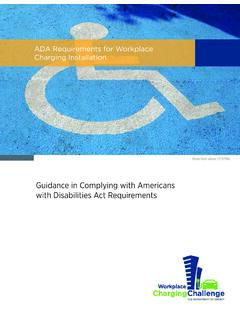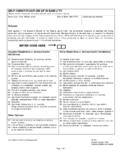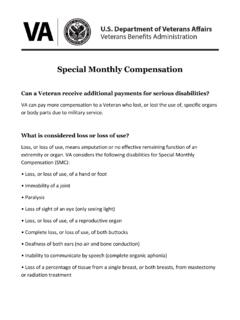Transcription of TRANSITION PLANNING FOR STUDENTS WITH DISABILITIES
1 November 2004. TRANSITION PLANNING FOR STUDENTS . WITH DISABILITIES . A Special Topic Report of Findings from the National Longitudinal TRANSITION Study-2 (NLTS2). Prepared for: Office of Special Education Programs Department of Education NLTS2 has been funded with Federal funds from the Department of Education, Office of Special Education Programs, under contract number ED-01-CO-0003. The content of this publication does not necessarily reflect the views or policies of the Department of Education nor does mention of trade names, commercial products, or organizations imply endorsement by the government.
2 SRI International 333 Ravenswood Avenue Menlo Park, CA 94025.. November 2004. TRANSITION PLANNING FOR STUDENTS . WITH DISABILITIES . A Special Topic Report of Findings from the National Longitudinal TRANSITION Study-2 (NLTS2). Prepared for: Office of Special Education Programs Department of Education Prepared by: Ren e Cameto, Phyllis Levine, and Mary Wagner SRI Project P11182. NLTS2 has been funded with Federal funds from the Department of Education, Office of Special Education Programs, under contract number ED-01-CO-0003. The content of this publication does not necessarily reflect the views or policies of the Department of Education nor does mention of trade names, commercial products, or organizations imply endorsement by the government.
3 SRI International 333 Ravenswood Avenue Menlo Park, CA 94025.. ACKNOWLEDGMENTS. The comprehensiveness and scale of the National Longitudinal TRANSITION Study-2. (NLTS2) makes it a daunting undertaking that is made possible only by the contributions of a large team. The authors' sincere thanks go to: Pat Gonzalez and Lou Danielson of the Office of Special Education Programs, Department of Education for their leadership and guidance in helping make NLTS2 and the OSEP longitudinal studies program such a valuable asset to our field. To Kathryn Valdes, Hal Javitz, Peter Godard, Cynthia Williamson, Mary McCracken, James Van Campen, and the rest of SRI's programming and data management team, whose technical expertise and responsiveness to innumerable and sometimes frantic analysts' requests makes a huge analytic task manageable.
4 To Marion Collins, Klaus Krause, Roxanne Jones, and the rest of SRI's administrative team for their unfailing support in bringing the study's products to the public. To our colleagues at Westat for their contributions as subcontractors in collecting the parent interview data reported here. To Paula Kohler and Ed O'Leary, who reviewed an early draft of this report, and to our many colleagues in the research, policy, practitioner, parent, and advocacy communities who have contributed their time and ideas to NLTS2 along the way. But none of the contributions made by the NLTS2 team would be meaningful without the generosity of over 9,000 youth with DISABILITIES whose stories we tell.
5 Our hats are off to them and to their parents and guardians for their time, openness, and insights. Finally, in a time when educators in America's schools are under unprecedented pressure to improve the academic performance of their STUDENTS , we are enormously indebted to the thousands of teachers and other school staff who have supported NLTS2 by taking the time to provide information on their STUDENTS ' school programs. i ii CONTENTS. Acknowledgments .. i Executive Summary .. ES-1. 1. PLANNING for TRANSITION from School to Adulthood for Secondary School Youth with DISABILITIES .
6 1-1. PLANNING and Services for the TRANSITION from Secondary School to Adult Life .. 1-1. Background on NLTS2 .. 1-2. Focus of the Report .. 1-3. Research Questions .. 1-3. Information Sources .. 1-3. Technical Notes .. 1-4. Organization of the Report .. 1-4. 2. TRANSITION PLANNING for STUDENTS with DISABILITIES .. 2-1. Initiation of TRANSITION PLANNING .. 2-1. STUDENTS ' TRANSITION Goals .. 2-2. Participants in TRANSITION PLANNING .. 2-3. TRANSITION Preparation and Supports .. 2-7. In-school TRANSITION Preparation and Supports .. 2-7. Postschool Service Needs Identified.
7 2-9. School Contacts with Service Providers and Organizations on Behalf of Transitioning STUDENTS with DISABILITIES .. 2-12. Informing Parents of Postschool Service Options .. 2-15. Disability Differences in TRANSITION PLANNING .. 2-15. Initiation of TRANSITION PLANNING .. 2-16. STUDENTS ' TRANSITION Goals .. 2-16. Participants in TRANSITION PLANNING .. 2-17. TRANSITION Preparation and Supports .. 2-20. School Contacts with Service Providers and Organizations on Behalf of Transitioning STUDENTS .. 2-22. Informing Parents about Postschool Services .. 2-23.
8 Demographic Differences in TRANSITION PLANNING .. 2-23. STUDENTS ' TRANSITION Goals .. 2-23. Participants in TRANSITION PLANNING .. 2-24. TRANSITION Preparation and Supports .. 2-25. iii 3. Family and School Staff Perceptions of IEP and TRANSITION PLANNING Processes 3-1. Perceptions of Decision-Making in TRANSITION PLANNING .. 3-1. Disability Differences in Perceptions of the IEP and TRANSITION PLANNING Processes . 3-3. Demographic Differences in Perceptions of TRANSITION PLANNING .. 3-4. 4. Emerging Themes Regarding the IEP and TRANSITION PLANNING Processes.
9 4-1. A Mixed Picture of TRANSITION PLANNING .. 4-1. The TRANSITION PLANNING Process Develops over Time .. 4-2. TRANSITION PLANNING Reflects a Diversity of Needs and Abilities .. 4-3. The TRANSITION PLANNING Process Reflects Income and Racial/Ethnic Differences .. 4-5. References .. R-1. Appendix A NLTS2 Sampling, Data Collection, and Analysis Procedures .. A-1. NLTS2 Sample Overview .. A-1. The NLTS2 LEA Sample .. A-2. The NLTS2 Student Sample .. A-4. Data Sources .. A-5. Weighting Wave 1 Data .. A-6. Estimating Standard Errors .. A-9. Unweighted and Weighted Sample Sizes.
10 A-10. Calculating Significance Levels .. A-12. Measurement and Reporting Issues .. A-12. References .. A-16. Appendix B Demographic Characteristics of Youth with DISABILITIES and Their Households .. B-1. Individual Characteristics .. B-1. Household Risk Factors .. B-5. Summary .. B-8. References .. B-9. Appendix C Unweighted Sample Sizes .. C-1. iv EXHIBITS. 2-1 STUDENTS Who Have Had PLANNING for TRANSITION to Adult Life, by Age .. 2-1. 2-2 Age TRANSITION Plan Began .. 2-2. 2-3 STUDENTS ' Post-High-School Goals .. 2-2. 2-4 Active Participants in TRANSITION PLANNING for STUDENTS with a TRANSITION Plan.

















